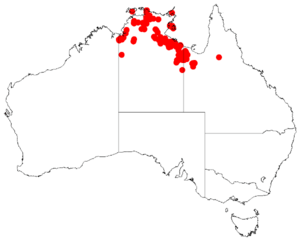Acacia alleniana facts for kids
Quick facts for kids Acacia alleniana |
|
|---|---|
 |
|
| A. alleniana foliage | |
| Scientific classification | |
| Genus: |
Acacia
|
| Species: |
alleniana
|
 |
|
| Occurrence data from AVH | |
Acacia alleniana is a type of shrub or small tree. It belongs to the plant group called Acacia, also known as wattles. This plant is special because it is only found in the northern parts of Australia.
What Does Acacia alleniana Look Like?
This shrub or tree often grows to about 5 meters (16 feet) tall. It has a thin, open shape with branches that tend to droop downwards. Its younger branches are slender and reddish-brown.
The plant has long, thin, leaf-like structures called phyllodes. These phyllodes can be 12 to 24 centimeters long and very narrow, only about 0.5 to 0.8 millimeters wide.
When it flowers, Acacia alleniana produces simple flower clusters. Each cluster has round flower heads with about 35 yellow flowers. After the flowers, long, thin, brown seed pods grow. These pods can be up to 15 centimeters long and 3.5 to 5 millimeters wide. Inside the pods are plump, dull brown seeds. The seeds are oval or egg-shaped and measure about 4 to 6 millimeters long and 2 to 2.5 millimeters wide.
How Was Acacia alleniana Named?
This plant was first officially described in 1917. Two botanists, A.J. Ewart and O.B. Davies, wrote about it. Their work was part of a larger book called The Flora of the Northern Territory, put together by Joseph Maiden.
Later, in 1987, another botanist named Leslie Pedley gave it a different scientific name, Racosperma allenianum. However, in 2001, it was moved back to the Acacia group, which is why it's now called Acacia alleniana again.
Sometimes, people confuse this plant with other similar wattles. It is often mistaken for Acacia juncifolia or Acacia tenuissima. Acacia alleniana is also closely related to Acacia jasperensis and Acacia juncifolia.
Where Does Acacia alleniana Grow?
Acacia alleniana is found naturally in the Northern Territory of Australia. You can see it from areas around Darwin stretching south and east into a region called Arnhem Land. It also grows on many islands in the Gulf of Carpentaria.
Its home extends into the far north-western part of Queensland. There, it likes to grow on hills and sandstone slopes. It prefers thin, sandy soils in these areas.

